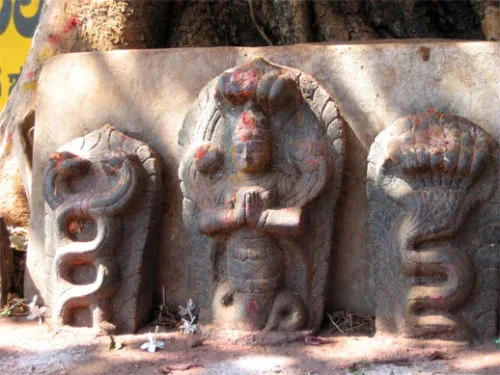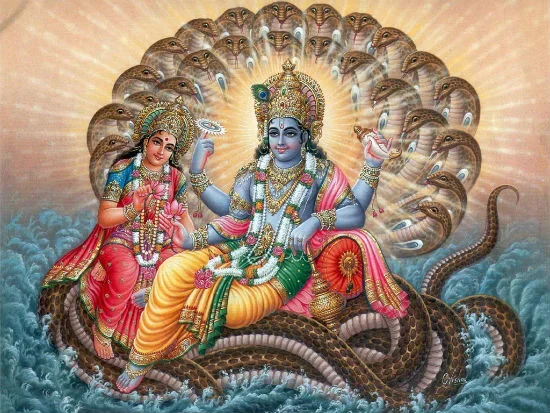Nag Panchami or Nagar Panchami falls on the fifth day of the bright fortnight of the lunar day in Shravan month. It occurs during July or August in the English calendar in the monsoon season. All the Hindus offer prayers to the snakes around their place on this day to appease the snakes and protect themselves from snake bites. It is a festival, which commemorates the significance of snakes, since the word ‘nag’ means snake and the word ‘Panchami’ means fifth day in the term ‘Nag Panchami’. Apart from Shravan month, people offer prayers to snakes on the fifth day after full moon day in Ashar month.
Mythological significance of the festival Nag Panchami:
This festival has rich mythological overtones, starting from the tremendous victory of Lord Krishna over the huge Kaliya in the Yamuna River. We have a further reference to Seshnag, the king of serpents, who was tamed by Lord Vishnu, as pictured in Ananda Padmanabha temple in Trivandrum of Kerala. The deity in the temple is Lord Vishnu, sleeping on the body of Seshnag. No wonder, the Keralites deem Nag Punchami as a huge festival and adore snakes on the day with piety. It is also considered as paying homage to Manasa, the serpent Goddess sister of Vasuki, the Snake who was used as a rope by the Devas and Asuras to churn the Milky Ocean. Nag Puja is carried out in Assam, Bengal, Jharkhand and Orissa in reverence of all snakes which have such a magnificent role in mythology. In Punjab, people celebrate Manasa Devi Ashtanag Puja (Guga Navami) by making a huge snake from flour and worshipping it. It is not only with Lord Vishnu, the greatness of snakes is associated; it is also with Lord Shiva- which is a very clear transparent concept, since it is the snake around the neck of Lord Shiva which inspires awe and piety on the very first look of the deity. Moreover in the Puranas, there is a reference to Brahma’s son’s wife as the mother of all nags.
There is also a mythological story about a goddess Sathyeshwari, whose brother Sathyeshwar died before the day of Nag Panchami. She grieved over the death of her brother without eating anything. She saw her brother in the form of a cobra and believed that it was her brother. So, Nagdev promised her that he would protect any woman who deems a cobra as her brother and worships it. Hence, it became the habit of Hindu women to worship snakes for the longevity and safety of their brothers on this day.
Historical background of Nag Panchami:
We find references in History regarding the sarpyadnya (sacrificial fire of snakes) performed by king Janmejay, who was requested to stop the ritual by the sage Astik. It was the day of Shravan Shukla Panchami and hence the celebration of Nag Panchami. It has the implied meaning that in this universe, all the living beings have their assigned functions of God and He performs those functions through the living beings. Actually speaking, during monsoon, it is natural for the serpents and other rodents come out of their holes due to rain and thereby they are seen in the surroundings. They should not hurt the human beings that such prayers are offered to propitiate them for human safety.
Rituals on Nag Panchami
General Beliefs about Nag Panchami
Thus, our customs and mythological background prove how worship of snakes can make one blessed with good things like safety, longevity, good prospects of married life and protection from evil.
-----
Article written by Sudha.S for tamilbrahmins.com
Mythological significance of the festival Nag Panchami:
This festival has rich mythological overtones, starting from the tremendous victory of Lord Krishna over the huge Kaliya in the Yamuna River. We have a further reference to Seshnag, the king of serpents, who was tamed by Lord Vishnu, as pictured in Ananda Padmanabha temple in Trivandrum of Kerala. The deity in the temple is Lord Vishnu, sleeping on the body of Seshnag. No wonder, the Keralites deem Nag Punchami as a huge festival and adore snakes on the day with piety. It is also considered as paying homage to Manasa, the serpent Goddess sister of Vasuki, the Snake who was used as a rope by the Devas and Asuras to churn the Milky Ocean. Nag Puja is carried out in Assam, Bengal, Jharkhand and Orissa in reverence of all snakes which have such a magnificent role in mythology. In Punjab, people celebrate Manasa Devi Ashtanag Puja (Guga Navami) by making a huge snake from flour and worshipping it. It is not only with Lord Vishnu, the greatness of snakes is associated; it is also with Lord Shiva- which is a very clear transparent concept, since it is the snake around the neck of Lord Shiva which inspires awe and piety on the very first look of the deity. Moreover in the Puranas, there is a reference to Brahma’s son’s wife as the mother of all nags.
There is also a mythological story about a goddess Sathyeshwari, whose brother Sathyeshwar died before the day of Nag Panchami. She grieved over the death of her brother without eating anything. She saw her brother in the form of a cobra and believed that it was her brother. So, Nagdev promised her that he would protect any woman who deems a cobra as her brother and worships it. Hence, it became the habit of Hindu women to worship snakes for the longevity and safety of their brothers on this day.
Historical background of Nag Panchami:
We find references in History regarding the sarpyadnya (sacrificial fire of snakes) performed by king Janmejay, who was requested to stop the ritual by the sage Astik. It was the day of Shravan Shukla Panchami and hence the celebration of Nag Panchami. It has the implied meaning that in this universe, all the living beings have their assigned functions of God and He performs those functions through the living beings. Actually speaking, during monsoon, it is natural for the serpents and other rodents come out of their holes due to rain and thereby they are seen in the surroundings. They should not hurt the human beings that such prayers are offered to propitiate them for human safety.
Rituals on Nag Panchami
- People go to Shiva temples and snake pits in the temples to offer prayers.
- They fast the whole day and take food only in the evening.
- It is only boiled food items which are eaten on the day and the nag devotees don’t fry anything.
- Similarly, the worshippers of snakes do not dig the ground for any purpose.
- Some offer bowls of milk before the holes and pits around their homes to pay respects to snakes in the vicinity.
- It is normally milk, which is offered with flowers and turmeric and kumkum. Some offer puffed rice.
- In the Bavishya Purana, it is said that the Nag devotees have to make an image of snake in gold, silver or clay and worship it with incense, jasmine and kaneer. They should feed Brahmins with ghee and Payasam on the day.
General Beliefs about Nag Panchami
- People believe that they will get rid of snake fear and snake bites if they worship snakes on this day.
- It is normally believed that there will be rain on the day as a symbol of God’s showering of blessings on people.
- If we do Naga archana or puja on this day, we will be rid of Naga Dosha or Kal Sarpa Dosha.
- If unmarried women fast and pray on this day, they will be blessed with good husbands.
- If you worship snakes on this day, you will be protected from evil and sin.
Thus, our customs and mythological background prove how worship of snakes can make one blessed with good things like safety, longevity, good prospects of married life and protection from evil.
-----
Article written by Sudha.S for tamilbrahmins.com


